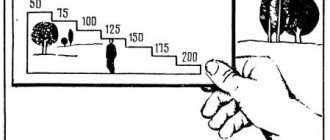More fish no need to feed?!
A school of fish is around your hook within 5 minutes of throwing the Fish MegaBomb into the water. There are no analogues! 53% discount only for New Year!
For summer fishing
For winter
Read more…
No one is immune from accidents, so you should always be ready to help. This article will describe in detail all the necessary actions that need to be taken to successfully rescue a person drowning in a pond.
First actions when seeing a drowning person
- When you see a drowning person, the first thing you need to do is notify specialized rescuers.
- If possible, throw a lifebuoy, an inflatable mattress, etc. to the drowning person.
- If you decide to swim to the drowning person yourself, you should remove as much outer clothing as possible, since it will only get in the way.
How to swim to a drowning person
- You need to swim up to a drowning person only from behind, because a person who is drowning is in a stressful situation and has practically no control over himself. He can grab onto his rescuer with considerable force and pull him to the bottom;
- If you cannot swim invisible to a drowning person, you need to dive a couple of meters before him and, swimming up to the drowning person, grab him. Thus, the victim will not be able to harm either himself or his rescuer.
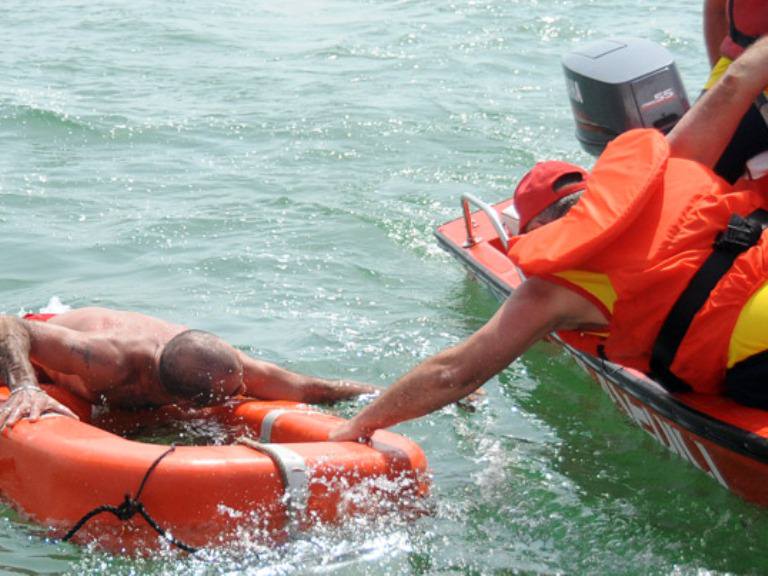
Capturing and transporting a drowning person
Methods of transportation depend only on the condition of the person who is drowning.
If the drowning person remains relatively calm, can control his body and obeys the advice of the person saving him, then he can be brought to land using this method: you need to swim on your stomach with breaststroke, and the drowning person should hold on to the rescuer’s shoulder, while lying on the water and helping The rescuer moves forward with small jerks with his legs.
If the person who is drowning is in shock or panic and does not understand what is being said to him, then it is better to use the following types of transportation:
I no longer have problems with fish biting!
Make it a rule, on every fishing trip, the first thing you do is...
Continue reading >>>
- Turn the person around and press him towards you, firmly grabbing him by the armpits or chin. Swim breaststroke on your back or side in this position.
- Turn the person's back to you and grab him by the armpits or head, swim breaststroke on your side in this position.
- Turn the person being rescued onto his back, grab him by the armpit with one hand and, clasping his forearm on the other side, swim on his side, rowing with his unoccupied arm and legs. This is the most difficult type of transportation and is used only when the drowning person is very scared.
- If a person is already submerged at the bottom of a reservoir, then he will need to dive and swim along the bottom where the victim may presumably be located.
- Having found a drowning person, you need to grab his armpits or arms, then push off with force from the bottom and emerge to the surface of the water, working as quickly as possible with your legs and unoccupied hand.
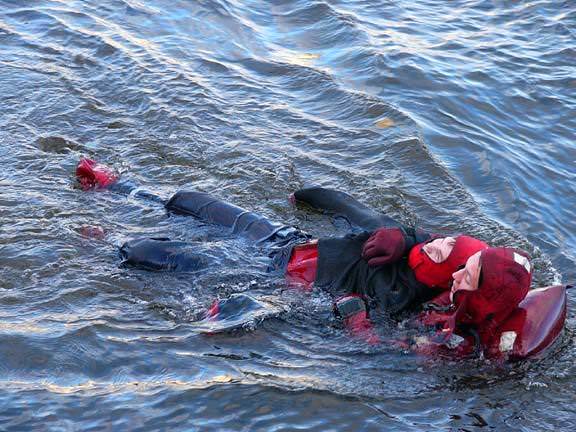
Having emerged, you should turn the person’s back to you and, without hesitating a minute longer, swim with him to the nearest shore:
- If a drowning person is at the bottom of a reservoir facing the bottom, then you need to swim to him from the feet.
- If he is at the bottom face up, then you need to approach him from the side of the head.
Types of drowning
The actions to take when rescuing a drowning person depend on the type of drowning. There are three types of them.
- White asphyxia, otherwise this type is also called imaginary drowning. From fear of water getting into the lungs, a person reflexively experiences a spasm, breathing stops and the heart stops. Such a drowned person can be revived after 20 minutes.
- Blue asphyxia occurs when water enters the alveoli of the lungs. It is easy to understand this by a person's appearance. The face, ears, lips, fingers acquire a purple tint to the skin. This one needs to be rescued urgently; the rescuer only has 5 minutes left.
- The next type of drowning occurs when there is depression of nervous processes. This happens under the influence of alcohol or hypothermia of the body. Rescue is given from 5 to 10 minutes.
Read also Sunburn: symptoms, first aid and treatment
Providing first aid to a drowning person on land
First aid to a rescued person who is already on land must be provided depending on the degree of complexity of his condition. The first thing to check is the presence of breathing and pulse. If these indicators are normal and he is conscious, then the victim should be placed on a flat area so that the level of the head is slightly lower than the pelvis. Then you should free him from all wet clothes, wrap him in a blanket and call the doctors. It is also allowed to give a person warm tea.
If a person remains unconscious even after removing the fluid, but breathes rhythmically and has a clear pulse, then you need to act in this way:
- Raise the rescued person's head up and push back his lower jaw.
- Place your head slightly below the level of the pelvis and, using your own index finger wrapped in a scarf, clear the oral cavity of dirt, algae, remnants of vomit and other contaminants.
- Bring the rescued person to consciousness using alcohol for ammonia.
- Find a doctor.

If the rescued person has no breathing, no pulse and lies unconscious and unconscious, then this is the most dangerous condition that can result in the death of a person. To prevent death in such circumstances, and to act correctly, you must first determine the type of drowning, a characteristic feature of which is the color of the skin of the drowning person.
There are two of them:
- "White."
- "Blue."
If a person has a white skin color, then this is a “white” or “false” drowning. The breathing of these drowned people was interrupted due to a spasm of the glottis under the influence of a reflex on it when liquid enters. This type of drowning is easier to deal with and the chances of survival are much higher.
If a drowned person has bluish skin or skin with purple spots or tints, swelling (especially in the area of the lips and cheeks), then this is most likely a “blue” or “real” drowning. The breathing of such drowned people stops due to the infusion of fluid first into the lungs and then into the blood, which immediately contributes to the complete shutdown of the heart. A characteristic sign of this drowning is also very swollen veins and profusely diverging foam from the mouth area.
The action plan for helping these people looks like this:
- Establishing good airway openness. To do this, you need to clean your mouth of all kinds of contaminants that interfere with the normal passage of air (grass, algae, silt and others). But it often happens that the jaws of a drowning person clenched tightly in a spasm, and to open his mouth you need to use the following methods:
- A teaspoon is inserted between the jaws of the rescued person into the area of the molars, after which the jaws are opened.
- With the help of four fingers inserted into the molar area, you can also open the jaws.
- In order to prevent a person’s jaws from closing again, you need to put some non-dangerous object between them (a scarf, a knot from a scarf, etc.). After completing the task of opening the mouth of a drowning person, you need to turn his head to the side and, with your index finger wrapped in a scarf, clean the mouth, nose and nasopharynx of all contaminants.
- Then remove the entered fluid from the lungs of the drowning victim. To do this, a person is turned onto his stomach and placed on the knee of his half-bent leg so that his head is slightly below the level of the pelvis. Then, with the help of your hands, the lower chest area of the victim is compressed. This procedure should be done no longer than 15 seconds, after which you should proceed to perform artificial respiration.
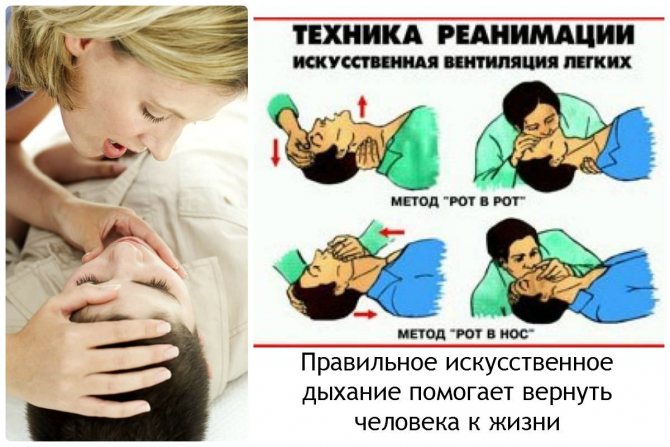
Artificial respiration and indirect cardiac massage are done in combination, so they are carried out almost simultaneously with the victim in the following order:
- The victim is placed on a hard surface, since on a soft surface during cardiac massage there is a risk of liver damage. Remove the belt and free the chest from excess clothing with buttons, fasteners, etc.
- The rescuer places his hand, palm down, on the victim's lower chest so that the axis of the wrist joint is the same as the long axis of the sternum. The rescuer places the other hand on the outer area of the first hand. In this case, all fingers on both hands should be slightly raised so that they do not come into contact with the chest during the massage. Any other position of the hands is unacceptable as it may be dangerous for the victim.
- Then the rescuer leans towards the victim and, with clasped hands, sharply presses on his chest. In this case, it is necessary that the pressure is not in the left zone of the chest, but in the middle (in the sternum). The pressing force should be no more than 50 kg, so this massage should be achieved not so much through the strength of your hands, but through your own body weight.
- After briefly pressing on the chest, you need to release it so that the heart can relax after such pressure.
- The rate of cardiac massage for adults is 65-70 shocks every 60 seconds. Children under 7 years of age should be massaged with only one hand, and infants with two fingers (index and middle) with a frequency of up to 100–110 thrusts per 60 seconds.
After each session of chest compressions, you need to perform artificial respiration.
This is done this way:
- The head of a drowning man is thrown back upward.
- The rescuer draws air into his lungs and holds the exhalation a little, after which he closes both of the victim's nostrils (so that the air cannot escape from them) and tightly clamps the mouth area with his lips.
- The rescuer then takes a quick breath into the victim's airway.
- After completing the inhalation, the rescuer moves away from the person.
- In the breaks before the next breath, the rescuer needs to take a couple of normal breaths for himself. After this, the process of performing artificial respiration is repeated again.
The frequency of breaths that a person needs to take during emergency resuscitation:
- Adults need to inhale air at least 12–16 times every 60 seconds.
- Children 25–30 times every 60 seconds.
- For young children - 40 exhalations every 60 seconds in small portions into the nose and mouth.
How to save a drowning person without drowning yourself?
We talk about the correct algorithm of actions in case of an emergency on the water.
— I saw your news about the men who saved a boy in Vyatka. And that there were no lifeguards on the beach at that time. A lot of people drown here during the summer, and I often go to the river. I would like to know what to do if you see a person drowning.
Let's start with the fact that swimming is officially permitted only on equipped beaches inspected by the Ministry of Emergency Situations. Swimming areas must be equipped with a rescue post, have visual limits to the swimming area (for example, buoys), and the bottom of the reservoir must be cleared. Otherwise, swimming in the reservoir is prohibited; you can only relax on the shore.
On this topic
“He was unconscious, his eyes were black, all the whites were covered in blood”: Kirov residents told how they rescued a boy who was drowning in Vyatka
2728
However, Kirov residents often neglect safety measures. Thus, since the beginning of the swimming season in the Kirov region, six people have already drowned, including children. Most of the accidents occurred in places where swimming is prohibited. However, there are exceptions: on July 14, two men rescued a 10-year-old boy drowning in Vyatka in the area of the city beach, where lifeguards were supposed to be there, but there were none. The city administration explained that lifeguards are on duty on the water in the area of the city beach only from 10 a.m. to 8 p.m. and only in warm, sunny weather. The rest of the time they only patrol the territory once an hour. Therefore, even on an officially equipped beach, rescuing drowning people can become the work of the drowning people themselves or other vacationers.
How to understand that a person is drowning
It is worth noting that recognizing a drowning person is not always easy. Contrary to popular belief, a drowning person will not loudly call for help, pull his arms out from under the water, or slam his hands on the water: all these signs are contrary to physiology. In order to scream, a person needs to breathe normally, and when drowning, their hands are instinctively used for something else: they are spread out to the sides to push off the water and swim upward.
Specialists from the State Inspectorate for Small Vessels of the Kirov Region identify the following signs of a drowning person:
- position of the mouth: in a drowning person, the head is usually immersed in water, and the mouth is located at the very surface and periodically goes under the water, then appears above the surface. So the body tries, while floating up, to inhale as much air as possible. Another position: the drowning person tilts his head back, opens his mouth;
- body position: a drowning person remains upright until the last moment. It may even seem as if the person is climbing an invisible rope ladder;
- hand position: drowning people cannot wave their hands to attract the attention of others. When they begin to drown, they instinctively stretch their arms out to the sides to push off the water. It doesn’t always work out, so if you see a person hitting the surface with his hands, be sure to check if everything is okay with him;
- gaze: most drowning people usually either close their eyes altogether, or stare blankly at one point, without focusing. Sometimes this may be the only sign of drowning. It is also worth paying attention to a person if his hair has covered his eyes, but he does not try to push it away.
If you see warning signs, call out to the person and ask if they are okay. If they don’t answer you or you get a blank look in response, you need to immediately begin rescue. But only if you know how to swim. If not, call for help.
Rescue technique
Having noticed a drowning person, determine if there is something at hand that can be thrown to the victim (rope, wooden board, lifebuoy, etc.). If there is nothing suitable, you should swim to the victim, after encouraging him with a shout.
When approaching a drowning person, you need to dive under him and, grabbing him from behind (you can grab him by the hair), swim to the shore. A drowning person may grab you by the arm, neck or legs. In this case, dive immediately - the instinct of self-preservation will force the victim to let you go.
If a person has already plunged into the water, do not stop trying to find him and then bring him back to life. This can be done even if the drowning person has been in the water for about 6 minutes.
Types of drownings
Having pulled the victim ashore, determine the type of drowning: the nature of first aid will depend on this. Drowning may be blue or pale, depending on the color of the victim’s skin.
Blue drowning occurs when a drowning person fights for his life until the last minute. Usually people who cannot swim or children who find themselves in the depths drown this way. With blue drowning, the victim’s skin becomes blue-gray, pinkish foamy liquid is released from the mouth, breathing becomes bubbling, frequent coughing with pinkish foamy sputum is characteristic, and the blood vessels of the neck swell greatly.
Pale drowning occurs when a person drowns unconscious (hits their head while diving or before falling into the water, loses consciousness from shock) or falls through the ice. At the same time, unlike blue drowning, water does not enter the lungs and stomach in large quantities, which increases the chances of saving the life of the victim. In case of pale drowning, the skin is gray, and there is no foam from the mouth and nose.
First aid to the victim
In case of blue drowning, the first thing to do is to throw the victim over the knee face down (a large person can be sharply lifted by the waist together), put two fingers in his mouth and sharply press on the root of the tongue to provoke a gag reflex and stimulate breathing.
On this topic
Where can and where can’t you swim in Kirov?
4102
If, after pressing on the root of the tongue, you heard the characteristic sound “E” and this was followed by gagging movements, if you saw the remains of eaten food in the water pouring out of your mouth, then in front of you is a living person with a preserved gag reflex. Indisputable evidence of this will be the appearance of a cough. For 5-10 minutes, continue to periodically press firmly on the root of the tongue until water stops coming out of the mouth and upper respiratory tract.
If, when pressing on the root of the tongue, the gag reflex does not appear, if there is no coughing or breathing movements, turn the person onto his back and immediately begin artificial respiration. You need to act similarly in case of pale drowning: you don’t need to waste time removing water from the lungs (there is none there), you need to immediately start artificial respiration.
If the victim has palpitations:
- kneel to the left of him, throw back the drowned man’s head as much as possible, open his mouth and plug his nostrils;
- take a deep breath, put your lips to the victim’s lips through a handkerchief or gauze (if you have them at hand) and exhale forcefully, count to four and repeat until breathing appears.
If there is no heartbeat
, artificial respiration must be combined with chest compressions:
- place the victim on a hard surface (it is useless to perform chest compressions on loose sand), kneel to his left, tilt the drowned person’s head back as far as possible, open his mouth and plug his nostrils;
- Place one palm across the lower part of the sternum (but not on the ribs!), the other - crosswise on top of the first. Press on the sternum so that it bends 3-5 cm and release. You need to bend with straight arms, strongly, with a push, using your body weight. After each blowing, do 4-5 pressures. Children and infants should not take a full breath to avoid rupture of the lungs. Children should apply pressure on the sternum with one palm, and for infants with two fingers;
- do 30 pressures, repeat the combination “2 breaths + 30 pressures” (for children the ratio is 2:15);
- do not stop resuscitation until emergency services arrive or until signs of life appear. It is possible to maintain life in a lifeless person through artificial respiration and cardiac massage for an hour.
As soon as the victim shows signs of life, place him on his side. He must remain in a stable condition until the ambulance arrives. Even if the victim’s relatives or friends insist on letting him go home, insist on an “emergency”: even after rescue, there remains a threat of repeated cardiac arrest, development of pulmonary edema, cerebral edema and acute renal failure. Only after 3-5 days can you be sure that the victim’s life is no longer in danger.
Rules of conduct on the water
To avoid a tragedy, the Ministry of Emergency Situations strongly recommends following the rules of safe behavior on water:
- You can swim only in permitted places; children must swim in the presence of adults, even if the child is not far from the shore;
- do not dive in unfamiliar places: there may be submerged logs, stones, snags, and metal rods at the bottom;
- do not play games in the water that involve grabbing;
- do not go into the water while drunk - this is the main cause of drownings;
- do not swim far from the shore without calculating your strength. This is dangerous even for good swimmers;
- do not swim up to passing ships, do not cling to them.
Briefly about the main thing:
- As a rule, a drowning person does not wave his arms or call for help, as is shown in films. In a drowning person, the head is usually immersed in the water, and the mouth is located at the very surface and periodically goes under the water and then appears on the surface; the body is in an upright position, the eyes are closed or the gaze is not focused.
- If you know how to swim, shout out to the drowning person and swim to him. Dive under it and, hugging it from behind, head towards the shore.
- Having pulled a person ashore, you need to quickly determine the type of drowning. In the case of blue drowning (this is the most common case), his lungs must be freed of water by pressing the root of the tongue with your fingers. If the victim does not show signs of life, immediately begin artificial respiration and chest compressions if there is no pulse.
- Continue resuscitation until the ambulance arrives. It is possible to keep the victim alive with artificial respiration for an hour.
- After a person begins to show signs of life, he needs to be placed on his side. He must be in a stable condition until doctors arrive.
If you have questions that you can't find the answer to, ask us and we will try to answer them.
Photo source: mchs.gov.ru
How to prevent drowning
To prevent disaster, you need to remember the following:
- If, while swimming in a pond, you realize that you have not calculated your strength and are starting to drown, then, first of all, you need to try to relax and lie on your back, and then call someone for help.
- Children should not be allowed to bathe independently without adult supervision.
- You cannot dive headfirst into unfamiliar bodies of water without knowing the proper depth and bottom.
- You should not swim while intoxicated or immediately after eating.
- It is not recommended to swim near bridges, cliffs, underwater holes, etc.
- You should not enter the pond after being in the sun for a long time, or if you are very tired.
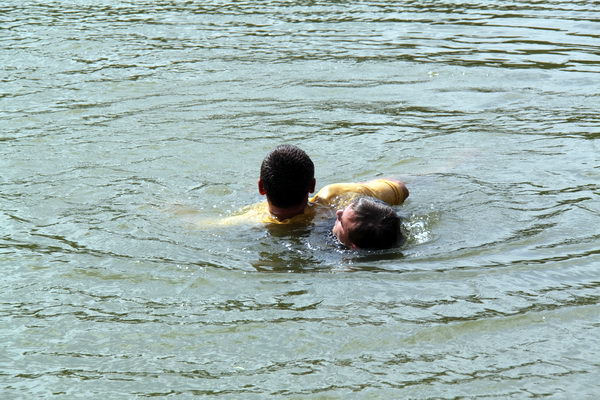
Drowning: Why do people drown?
Drowning is one of the most common causes of death. According to WHO, death from drowning is the third leading cause of death due to unintentional injuries.
Thousands of people drown every year around the world. Most often these are men and children. Men often drown due to alcohol intoxication or excessive self-confidence, children - because they are too defenseless, they do not understand the danger of water.
In Australia, drowning is the leading cause of death among children aged 1–4 years. In Bangladesh, more than 40% of child deaths are from drowning. The numbers are not very encouraging. In Russia, too, every year many people become victims of accidents. The problem is relevant, we need to talk about it in order to prevent and avoid tragedy.
Most accidents occur in the spring and summer. When it’s hot outside and many people go to bodies of water to swim, swim and freshen up. With the beginning of the swimming season, rescuers have more work, but rescuers do not always come to the rescue on time.
Reasons why people drown:
- The main cause of drowning is alcohol. When a person is drunk, he is not able to adequately control himself and his powers. Intoxication can cause unpredictable reactions; a person simply may not realize what is happening to him.
- Childhood. A few minutes are enough for an irreparable tragedy to occur. You should never leave children near the water themselves, even near the shore.
- Inability to swim. Non-swimmers must wear a special vest or lifebuoy in the water.
- Cold water. Bathing water should be comfortable. When the temperature is below 17°, not everyone can feel relaxed. Cold water can cause cramps, which will interfere with swimming.
- Strong current. It can carry a person away and exhaust him trying to get out.
- Injuries. The resulting injury can cause drowning; you should never jump into the water if you are not familiar with the bottom. This should be the golden rule.
- Health problems. A person in water may experience an epileptic or heart attack.
You don't have to go deep to drown. It is enough that your head may end up under water. It is worth remembering that if a person begins to drown, he can be saved. Timely assistance can save a person's life. It is only important to know what and how to do.
Theoretical knowledge is given to children at school. From childhood, children are taught how to save a drowning person. It is important to have time to apply your knowledge in practice.
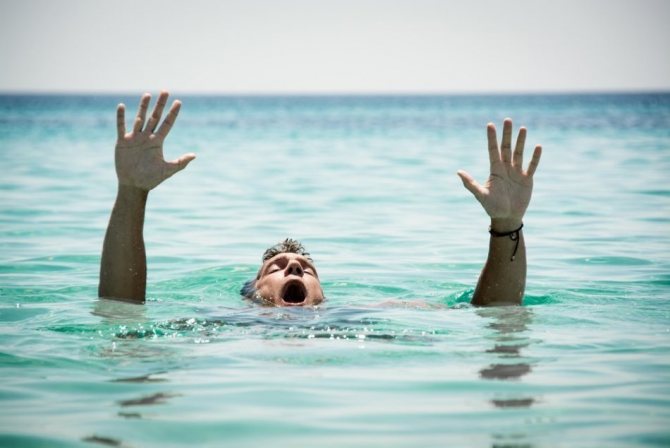
Drowning is a complex process. But from the moment a person begins to drown to death, very little time can pass.
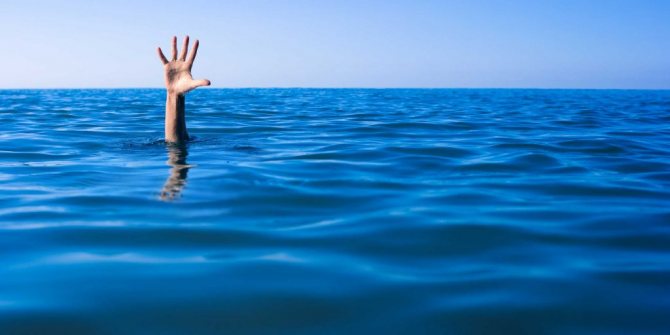
Death occurs because the respiratory organs fill with water. The man can't breathe.
Drowning in different types of liquids can occur differently. It happens that people drown not only in an open body of water, but also in a large container with milk or gasoline.
There are the following types of drowning:
- True. It can be in salt or fresh water. Water enters the lungs, mixes with the blood, and hemodilution begins. At this time, a drowning person depletes the body's resources through struggle. At the initial stage, he is conscious, breathing is not yet impaired, but the person is excited. At the agonal stage, consciousness and breathing are impaired, but blood circulation is preserved. Then clinical death occurs. True drowning is also called “pale” because of the color of the skin.
- Asphyxial. This type of drowning is characterized by the fact that water may not get into the lungs at all. But laryngospasm occurs. The receptors in the throat are irritated by water, and the drowning person begins to choke.
- Syncope. In this type, very little water enters the lungs, and death occurs as a result of cardiac arrest. Due to a sharp spasm of blood vessels, breathing also stops.
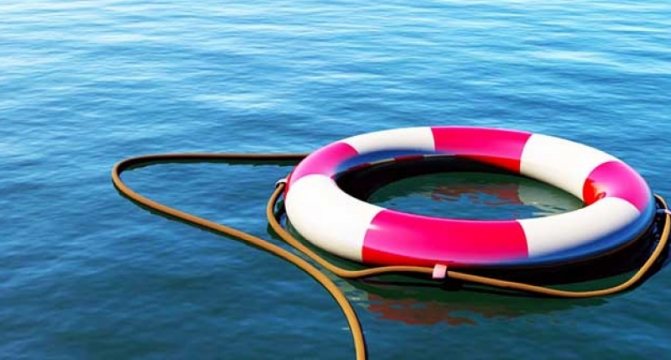
It is usually believed that a drowning person screams, asks for help, and attracts attention with his hands. This is wrong. Otherwise, cases would not occur when people drown in front of dozens of people.
There is a concept called “instinctive reaction of a drowning man”:
- The arms of a drowning man are extended to the sides, the person does not wave them. Stretching out arms in different directions occurs unconsciously, the person makes attempts to float up.
- The drowning person is in an upright position. As long as there is an instinctive reaction, he is able to be in this position for only up to 1 minute. Then the body is completely submerged under water.
- The mouth is always under water, then above water. A person cannot call for help, he simply does not have the opportunity. He throws all his strength into fighting and surfacing.
- A drowning person does not make meaningful movements. He will not grab the circle thrown to him or the hand.
Under no circumstances should you hesitate. We need to act quickly and immediately. How to save drowning people, read below.
If a person still calls for help, screams, this does not mean that he does not need help. But this is a completely different stage, which is called panic. Such panic may not last long; it precedes an instinctive reaction. In this case, the drowning person is still able to help the rescuer: he can reach out and grab the circle.
If you think a person is acting strangely in the water, talk to him. If he looks at you with an incomprehensible look and flounders in the water. Ask if everything is okay. If there is no response, you have little time, about 30 seconds.
Other signs that indicate a drowning person:
- The eyes are not focused on anything.
- The mouth is open and the head is thrown back.
- The person always tries to lie on his back.
- Doesn't remove hair if it's on his face.
- The head is located low above the water, the mouth is in the water. Sometimes the mouth is above the water and greedily gasps for air.
- A person does not swim away from one place, but climbs on the same place, his gaze is directed to one point.
- There are signs such as chills and shortness of breath. But it is impossible to determine them from afar.

A person is drowning - how to understand this?
Children behave the same way as adults if they suddenly start to drown. They begin to flounder in the water, throw back their heads, and greedily gasp for air.
But there are a few warning signs. An empty circle or mattress can give away the fact that trouble is nearby. If you see an empty mattress or circle floating, look around.
Don't forget that a child can even drown in a bathtub. You should never leave small children there on their own. where they may be in danger.

Memo
The rescuers are experienced professionals, they know what to do to prevent themselves from getting caught. Everyone should know these rules.
What do we have to do:
- Swim up to the drowning man from behind. He shouldn't see that you will save him.
- There are three ways to help transport a drowning person from the water and avoid drowning yourself during rescue.

Turn the drowning person onto his back, then sharply grab his armpits or head. Pull along with your legs.
Place one hand in the drowning person’s armpit, and with the same hand grab the chin. Guide your chin with your hand so that your mouth is always above the water. Use your feet and free hand to row to the shore.
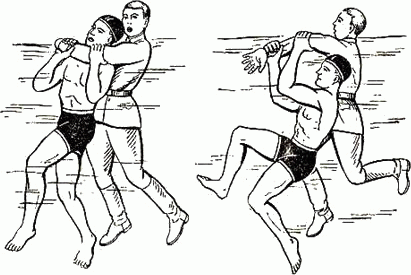
How to save a drowning person
Lay the drowning person on his back, place your hand under his armpits. Hold your forearm with your hand. Thus pull to the shore.
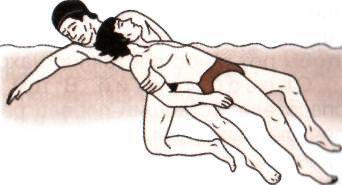
Method of salvation
When you realize that you are wasting time and the person has gone to the bottom, dive. After you grab it, push off the bottom very vigorously with your feet to find yourself on the surface.
It is very important to feel confident in the water and to realistically assess your strength. A fragile person can easily save a person larger than himself, because the weight is not felt in the water.
We suggest you read: Catfish attack on a person
A quick response is more important here.
- If there are other people on the beach, be sure to tell them that there is a problem. First, they will call an ambulance. Secondly, they will help save a drowning person. It's good when there are rescuers. But this does not happen on all beaches.
- A plastic bottle, rope, T-shirt, towel, air mattress, circle can help you. Anything that a drowning person can grab onto. If he can still do it. Even if the object is not able to support a person, it can give him confidence and help overcome panic.
- When “towing” a drowning person, try to calm him down. Tell him that everything is fine, that you will save him. This way the person can calm down and stop resisting.
Saving a drowning person is a very difficult process physically and mentally. Being in the water with a frantically panicked person can be deadly for both the drowning person and the rescuer. Therefore, realistically assess the situation and your strengths.
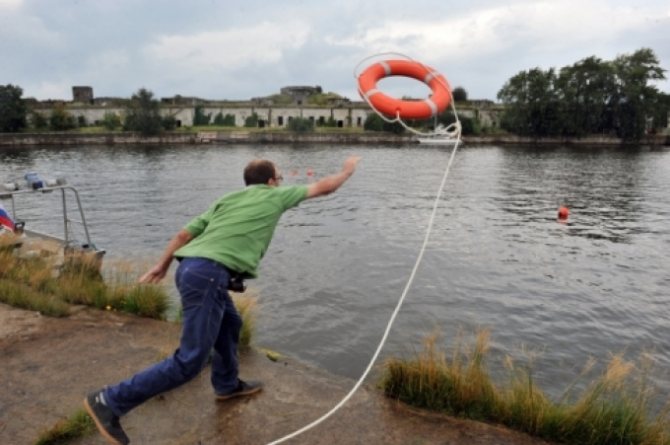
Save a drowning man
Ambulance doctors carry out a number of measures that will help restore breathing and also empty the stomach of water.
If a person has feelings and feels normal, you still can’t let him go. There is a possibility of “secondary drowning”, when death occurs after medical assistance to the victim.
The victim is taken to the hospital, where their health condition is monitored and complications are treated.
- Do not Cry. You will grab water, but you will not be able to scream.
- Taking a deep breath will help you stay horizontal. Hold the air, then exhale it slowly.
- You can try to squeeze with a “floater”. Take a breath and lower your face into the water. Press your knees towards your body with your hands. Exhale into the water, then inhale in the air, exhale again in the water.
- If your foot is cramped, pinch or pull yourself hard on your big toe.
- If your hand cramps, clench it into a fist. This will relieve painful squeezing of the hand.
Quick tips for rescuing a drowning person and providing assistance
- You should not rush to the aid of a drowning person if you are a poor swimmer or simply unsure of your abilities.
- During transportation of the victim, you should ensure that his mouth and nose are constantly above the water level - this will protect the person from additional infusion of liquid.
- During artificial respiration, a lot of air enters the person’s stomach and bloating occurs, which can delay the onset of consciousness, so you need to periodically apply a little pressure on the victim’s pancreas in order to free it from excess air.
- You cannot press on the chest and blow air into a person at the same time. This should be done alternately: 5 presses and one inhalation.
Ways to save a drowning person
If you see a drowning person, it is important to urgently take measures to save him. After all, it only takes a few minutes for a person to drown.
It is extremely important to assess the situation as soon as possible and choose the optimal method of providing assistance. Providing assistance to people in distress on the water is in practice divided into two types: providing medical assistance to a drowning person and actually rescuing a drowning person.
This is interesting: How to knit a double fishing clinch knot: diagram
